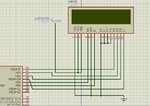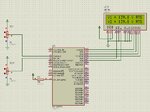Prince Vegeta
Member level 5

- Joined
- May 29, 2012
- Messages
- 84
- Helped
- 0
- Reputation
- 0
- Reaction score
- 0
- Trophy points
- 1,286
- Activity points
- 2,011
I connected the LCD as shown in the attachments.
and the C program of PIC16F877A have the following:
The LCD gets launched and it's light is on, and there is some black things in the 1st row and I read it should be working like this.
BUT, the readings never get shown!
THEN, I tried the PIC without LCD and surprisingly it stopped working like before (it was working with other functions).
So, what do you suggest?
and the C program of PIC16F877A have the following:
Code:
// LCD module connections
sbit LCD_RS at RB4_bit;
sbit LCD_EN at RB5_bit;
sbit LCD_D4 at RB0_bit;
sbit LCD_D5 at RB1_bit;
sbit LCD_D6 at RB2_bit;
sbit LCD_D7 at RB3_bit;
sbit LCD_RS_Direction at TRISB4_bit;
sbit LCD_EN_Direction at TRISB5_bit;
sbit LCD_D4_Direction at TRISB0_bit;
sbit LCD_D5_Direction at TRISB1_bit;
sbit LCD_D6_Direction at TRISB2_bit;
sbit LCD_D7_Direction at TRISB3_bit;
// End LCD module connections
// LCD text variables
char txt1[] = "V1 = ";
char txt2[] = "V2 = ";
char txt3[6] = " ";
char txt4[6] = " ";
char txt5[] = "V RMS";The LCD gets launched and it's light is on, and there is some black things in the 1st row and I read it should be working like this.
BUT, the readings never get shown!
THEN, I tried the PIC without LCD and surprisingly it stopped working like before (it was working with other functions).
So, what do you suggest?





